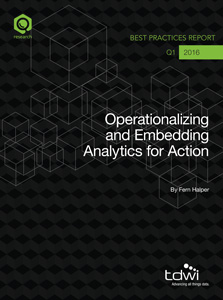
Best Practices Report | Operationalizing and Embedding Analytics for Action
December 21, 2015
As the pace of business continues to accelerate, forward-looking organizations are beginning to realize that it is not enough to analyze their data; they must also take action on it. To do this, more businesses are beginning to systematically operationalize their analytics as part of a business process.
Operationalizing and embedding analytics is about integrating actionable insights into systems and business processes used to make decisions. These systems might be automated or provide manual, actionable insights. Analytics are currently being embedded into dashboards, applications, devices, systems, and databases. Examples run from simple to complex and organizations are at different stages of operational deployment. Newer examples of operational analytics include support for logistics, customer call centers, fraud detection, and recommendation engines to name just a few.
Embedding analytics is certainly not new but has been gaining more attention recently as data volumes and the frequency of data continue to increase. Companies realize that making analytics programmatic by automating operational decisions can be beneficial to both the top and bottom line. Another big advantage of operationalizing analytics is that it makes it more consumable. Consumability has become a hot topic because it makes analytics available to a wider group of people than simply those who analyze data or develop models and share it with a select few. As more people use analytic output, its value increases.
TDWI Research finds that respondents are already operationalizing analytics in dashboards though often these are static dashboards that are updated once daily or at longer time intervals. However, interest and action are building for a wide range of embedded and operationalized analytics, including programmatically automated analytics. Interactive dashboards are being used more. Organizations continue to embed analytics into applications. Embedding analytic applications into mobile devices is beginning to gain steam. Likewise, taking automated action using more advanced models such as predictive models is also gaining traction. Excitement is growing.
There are challenges, too: lack of trust in the data and the results ranks high on the list as does obtaining the right skill set. However, organizations are moving step by step to overcome these challenges. For those enterprises that operationalize analytics, the results can be rewarding. In fact, those respondents who measured top- and/or bottom-line impact with their analytics initiatives were more likely to embed analytics into their business processes than those who did not. This is due to a few factors, such as analytics maturity, and drives home the value of analytics.
This TDWI Best Practices Report focuses on how organizations can and are operationalizing analytics to derive business value. It provides in-depth survey analysis of current strategies and future trends for embedded analytics across both organizational and technical dimensions including organizational culture, infrastructure, data, and processes. It looks at challenges and how organizations are overcoming challenges. The report offers recommendations and best practices for successfully operationalizing analytics in the organization.